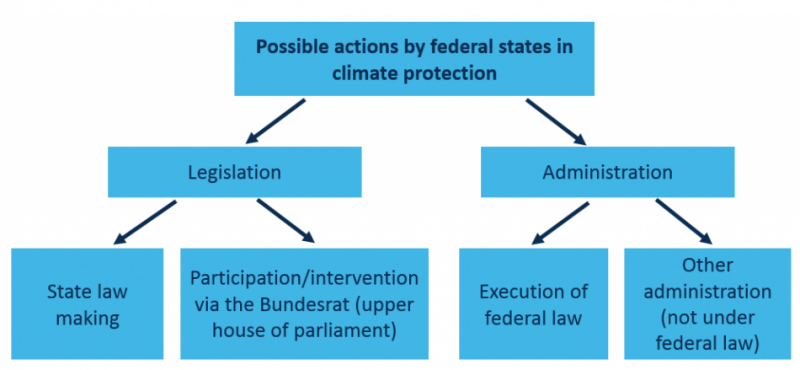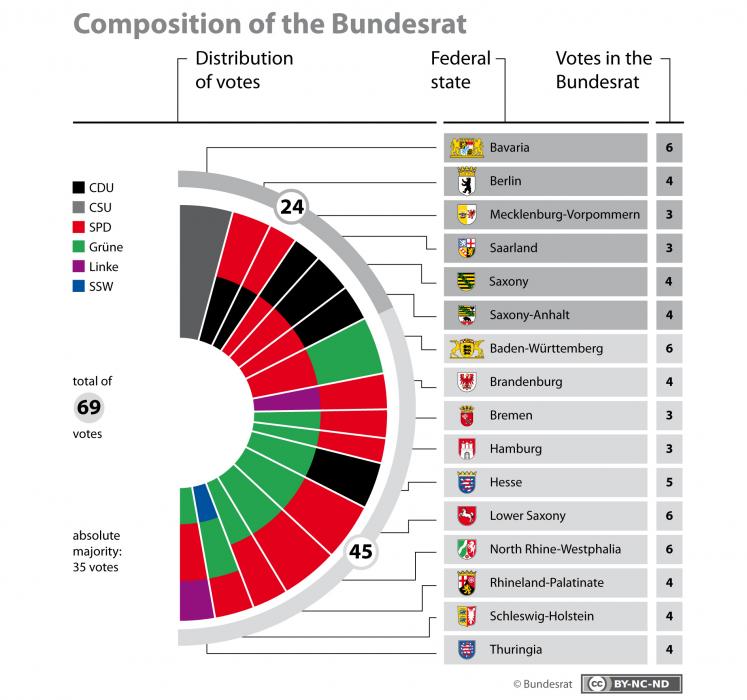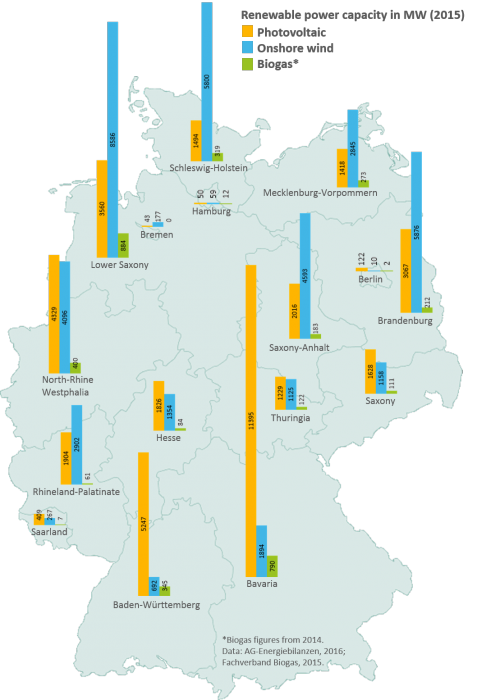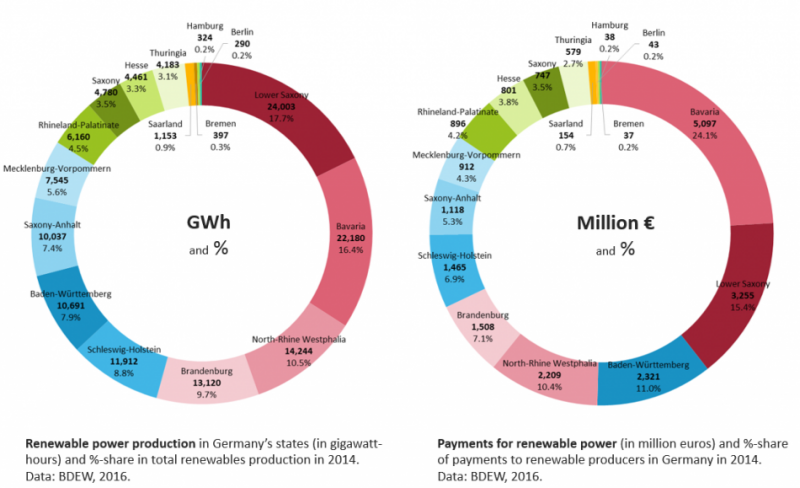German federalism: In 16 states of mind over the Energiewende
-
Influence of federal states on energy transition and climate protection – page 1
-
State motivation for climate protection and renewable promotion – page 2
-
Energy transition targets in federal states – page 2
-
Energy transition achievements in the federal states – page 3
-
State positions on main energy transition issues – page 4
The Federal Republic of Germany comprises 16 federal states (Bundesländer) each of which has its own priorities concerning the energy transition (Energiewende). It is generally acknowledged across state and party borders that Germany has to reduce its CO2 emissions to combat climate change, and that transforming the energy supply to a system based on renewables is therefore necessary. But the shades of approval and activism for this generational project vary among the state governments and state parliaments (Landtage).
Some observers argue that federalism leads to a healthy competition as some regions move ahead more quickly (also than the federal state) and act as examples to others. But other commentators believe development is delayed and made more complicated by every Bundesland having its own energy transition concept. This factsheet looks at the influence that Germany’s states have on energy and climate policy in the federation, on their achievements, motivations and positions in the Energiewende.
Influence of states on energy transition and climate protection (legislation)
Germany’s states have limited authority when it comes to climate and energy legislation. The privilege to make laws on the energy industry, transport sector and emissions lies largely with the federal government in Berlin. The most important law for promoting the energy transition, the Renewable Energy Act - which regulates payments for renewable installations - as well as transmission grid planning, the power market design and efficiency rules, are enacted on a federal level. However, the states can pass bills that specify or toughen efficiency rules in their own building and planning laws. For example, the state of Baden-Württemberg has a Renewable Heating Law that sets tougher requirements on refurbishing boilers in existing buildings than the federal state.
As all the state governments are also represented in the Bundesrat, the second or upper parliamentary chamber of the Federal Republic of Germany, they also have a say on the federal bills passed.
- Influence via the Bundesrat
There are two types of federal laws: objection bills and approval bills. For an approval law to be passed, the Bundesrat has to vote in its favour. Approval laws often concern the financial issues of the states. Against an objection bill, the Bundesrat can only raise its objections - and thereby delay the legislative process or trigger changes to the bill. But if a majority in the Federal Parliament (Bundestag) once more votes in favour of the bill after it has been discussed in a mediation committee, it passes without the consent of the states’ chamber. Most climate-related bills are objection bills.
Each state has a set amount of votes in the Bundesrat, depending on its size. The state governments send elected MPs, ministers and state premiers from the ruling party or coalition parties to represent them in the Bundesrat. The party structure of the Bundesrat is therefore dependent on the composition of the state parliaments and changes after state elections. Because the representatives of the state almost always cast all their votes unanimously, the coalition set-up of the Bundesrat matters. Before the next elections on 13 March in Baden-Württemberg, Saxony-Anhalt and Rhineland-Palatinate, the Bundesrat showed a majority of state governments with Social Democrats and Green Party participation. Government coalitions of Social Democrats (SPD) and Christian Democrats (CDU/CSU) in Saarland, Saxony, Saxony-Anhalt, Berlin, Mecklenburg-Vorpommern and Bavaria - mirroring the federal government coalition in Berlin - have 24 votes in the Bundesrat. To achieve an absolute majority, governments with a coaltion of left leaning SPD and Linke could cooperate. Or the SPD-CDU coalition parties can gather support from states where the Green Party (Grüne) governs with one of the two. The ruling “grand coalition” (SPD-CDU/CSU) in federal parliament has therefore no automatic majority in the Bundesrat. Moreover, interests of state parties often differ from the federal party line, particularly when it comes to questions of grid expansion or renewables support (see page 4 below).
Nine out of 16 environment ministers in the states are Green Party members (in Lower Saxony, Bremen, North-Rhine Westphalia, Thuringia, Hesse, Hamburg, Schleswig-Holstein, Rhineland-Palatinate, Baden-Württemberg - on 10/03/2016).
- Influence via state administration
Since the states’ administration is often in charge of implementing federal law, state governments have means to interpret and put different emphasis on certain rules, albeit within quite strict limits. The states are more free to shape their own climate protection efforts within their other administrative tasks, for example when proscribing efficiency and renewable obligations for the state properties.
Governments and councils enact planning laws on state level and below. This gives them, for example, the power to decide where wind turbines may be build or where to establish protected areas and how to interpret nature protection rules. This means that states can either facilitate the growth of renewables by introducing generous planning permissions, or hamper the expansion of renewable technologies by toughening environmental and planning requirements (see 10-H-rule in Bavaria on page 4 below).
Other major state-administered climate protection efforts are information campaigns and support programmes. Many states have established energy agencies to advance renewables and efficiency.
State motivation for climate protection and renewable promotion
Different states have different reasons for pursuing climate action, a study by the Federal Environment Agency (UBA) found. Some feel morally obliged to combat climate change. Others, such as coastal Schleswig-Holstein, took action after studies warned that global warming would lead to economic losses. The attention of others was focused on energy and climate policy after the nuclear accident in Chernobyl and the oil crisis at the end of the 1970s.
An element of competition between the states leads them to compare their respective climate actions and try to achieve more than the others, the study found.
Energy transition targets in federal states
Many federal states have their own energy transition targets and even their own climate protection laws (see table below). North Rhine-Westphalia was the first state to enact a law on promoting climate protection in 2013. It wants to cut CO2 emissions by 25 percent by 2020 and 80 percent by 2050.
Baden-Württemberg has an “integrated energy and climate protection concept”, based on a 2013 climate protection law. The targets include a greenhouse gas reduction of 25 percent by 2020 and by 90 percent in 2050.
Brandenburg’s “energy strategy 2030” includes a target of 32 percent renewables in primary energy consumption by 2030 and requires annual monitoring reports. The city state of Berlin wants to become “climate neutral” by 2050.
But not all states have found a majority for a climate protection law. Law proposals by Green Party Parliamentary Groups in Thuringia, Brandenburg, Saxony-Anhalt, Hesse and Saarland have not borne fruit.
Different Bundesländer have varied approaches when it comes to targets for renewables, statistics and information on development, enabling facilities for renewable growth and societal acceptance of renewables, and grid expansion, according to a comprehensive comparison report in the 16 federal states by researchers from the German Institute for Economic Research (DIW), ZSW and AEE. The states also score differently in each category. No state has found the silver bullet but nearly all of them have put targets and a promotion system in place. In the 2014 report, Bavaria ranks highest followed by Baden-Württemberg. The two states have been most successful in promoting renewable energies and using them. Saarland and Berlin score lowest in the overall comparison.
It becomes clear that the states’ ambitions vary considerably when comparing the renewable targets. Variations include whether the states want to achieve a certain percentage of renewables in final energy consumption (all energy, including heating and transport) or “just” in electricity consumption.
|
Baden-Württemberg |
-25% greenhouse gas emissions (GHG) by 2020; -90% by 2050 |
78% renewables in final energy consumption by 2050 |
|
Bavaria |
|
50% renewables in power consumption by 2021; 21% renewables in final energy consumption by 2021 |
|
Berlin |
-40% GHG by 2020; -60% by 2030; -85% by 2050 (climate neutrality) |
|
|
Brandenburg |
32% renewables in primary energy consumption by 2030 |
|
|
Bremen |
-40% GHG by 2020 (excluding steel industry emissions); -80% to -95% by 2050 |
100% renewables in power and heat supply by 2050 |
|
Hamburg |
-50% GHG by 2030; -80% by 2050 |
Wind power: 225-340 GWh per year by 2020 |
|
Hesse |
|
100% renewables in final energy consumption (without transport) by 2050 |
|
Mecklenburg-Vorpommern |
|
Increase use of renewables in power usage 5.6 times and in heating by 4.8 times (2011) updated concept 2015 |
|
Lower Saxony |
Climate Protection Law pending |
25% renewables in final energy consumption by 2020 – in the long term 100% renewables |
|
North-Rhine Westphalia |
30% renewables in power consumption by 2025 |
|
|
Rhineland-Palatinate |
100% renewables in power consumption by 2030 |
|
|
Saarland |
|
20% renewables in power consumption by 2020 |
|
Saxony |
|
28% renewables in power consumption by 2022/23 |
|
Saxony-Anhalt |
|
26% renewables in primary energy consumption by 2030 |
|
Schleswig-Holstein |
-40% by 2020; -55% by 2030; -70% by 2040; -80 to -95% by 2050: According to draft Climate Protection Law |
300% renewables in gross power consumption by 2025; fossil fuel free heating sector by 2050; 22% renewables in heating supply by 2025 |
|
Thuringia |
|
45% renewables in net power consumption by 2020; 30% renewables in final energy consumption by 2020. New energy strategy pending |
Energy transition achievements in the federal states
Germany’s Energiewende has so far mainly transformed the power sector. More and more power is produced in decentralised locations by households, citizen cooperatives and smaller companies instead of fossil and nuclear electricity generated in large central power plants. Onshore wind power and photovoltaic installations have been key to this development, which was triggered by the generous feed-in tariffs of the first Renewable Energy Act in 2000. The 16 federal states boast different amounts of renewable capacity depending on their size and location, political framework conditions, as well as on the readiness and financial resources of their citizens.
Five states - Bavaria, Brandenburg, Lower Saxony, North-Rhine Westphalia and Schleswig-Holstein - generated over 60 percent of the renewable power (biogas, solar, wind) produced in Germany in 2014.
Citizens in southern states like Bavaria and Baden-Württemberg, as well as those in North-Rhine Westphalia, have mainly invested in solar power (over half of the photovoltaics capacity in Germany is installed in these states (2015).
But the bulk (almost 70 percent) of onshore wind power is located in the north, north-east and north-west, in Lower Saxony, Schleswig-Holstein, Brandenburg, Saxony-Anhalt and, again, North-Rhine Westphalia.
The majority of biogas capacity is found in southern states such as Bavaria, Baden-Württemberg, but also in the agricultural states of Lower Saxony and Schleswig-Holstein, as well as North-Rhine Westphalia.
Renewable power generators in Bavaria, Baden-Württemberg, Lower Saxony and North-Rhine Westphalia receive over 60 percent of payments that are made via the renewable energy surcharge paid by German households on electricity bills.
Three states, Mecklenburg-Vorpommern, Saxony-Anhalt, Thuringia, produce more than half of their electricity from renewable sources. Lower Saxony, Schleswig-Holstein, Hesse, Rhineland-Palatinate and Bavaria generated between 35 and 45 percent of their power from renewables in 2014.
Germany’s most highly populated and industrialised state of North-Rhine Westphalia is one of the largest producers of wind and solar power. But compared to its overall electricity output (mainly from coal), this makes up only around 9 percent of its power generation.
Thuringia, a state that has to import electricity and has one of the lowest productions of renewable power among non-city states, poses a 55 percent share of renewables in net power generation.
State positions on main energy transition issues
Broadly speaking, there is a north-south divide on what the energy transition should involve. Northern states, such as Schleswig-Holstein, Bremen, Mecklenburg-Vorpommern, Lower Saxony, Hamburg and Bremen, are in favour of fast renewable development, particularly of onshore and offshore wind. They would also like to see large new grid connections built to deliver the renewable energy from the windy north to the industrial centres of the south. Southern states, such as Hesse, Baden-Württemberg, Rhineland-Palatinate and Bavaria, are more invested into solar power and biogas and have been critical of new power line connections.
States in the north, which tend to be less populated and less industrial than southern and western regions, see the energy transition as an opportunity to establish more manufacturing (i.e. wind power industry) in their states. They also see the chance to give citizens the option to invest into decentralised renewable power plants, which generates income for them and the local communities. Economically-weak regions along the coast have seen a renewables boom that has benefited both individual households and also the municipalities’ budget, as windfarms and renewable cooperatives are paying industry taxes.
- Renewables expansion and fossil fuel policy
With another reform of the Renewable Energy Act (EEG) in full swing, positions in the 16 states on the new auction system for wind and solar, as well as on the proscribed expansion corridors for the different renewable technologies, are crystallising. Northern states of Bremen, Hamburg, Lower Saxony, Mecklenburg-Vorpommern and Schleswig-Holstein have teamed up with the wind industry association (BWE) and metal workers’ union IG Metall. They have united to call for a consistent development of onshore and offshore wind, without using the 40-45 percent renewables target by 2025 as a ceiling or a limit to wind energy expansion depending on the growth of other renewables.
Green energy transition minister Robert Habeck, from Schleswig-Holstein, has repeatedly criticised the change to an auction model, saying that it could reduce citizen participation in the Energiewende. He also warned that reducing the expansion corridor for onshore wind could have “dramatic effects” on wind energy expansion in the north.
Citizens in northern Germany are more supportive of the energy transition than southerners, a February 2016 poll showed. But even though the northern German states can be considered economic winners of the renewables development, some citizens have come to oppose further wind farms. In Mecklenburg-Vorpommern, the first party of anti-wind power activists “Free Horizon”, was established in early 2016. Just like in the south, wind power opponents argue that the turbines are “destroying the cultural landscape”.
While most states try to shape favourable conditions for more wind power development, Bavaria’s government in 2014 introduced the so-called “10-H-regulation”. It proscribes that new wind turbines have to be a distance of ten times their height away from the nearest settlement. With modern wind turbines this means that the next house must be 2 kilometres away (instead of 800 m). The German Wind Energy Association (BWE) has presented figures saying that the new policy has basically prevented any new wind power development in Bavaria. Since the beginning of 2015, Saxony is also discussing the implementation of a 10-H-regulation.
Southern German states are in favour of the so-called “reference yield model” which is and, very likely will be again, part of the Renewable Energy Act. The mechanism makes sure that wind turbines are also built in areas which do not have the strongest wind by guaranteeing them a higher remuneration depending on their yield expectations. Climate and energy ministers from Hesse, Saarland, North-Rhine Westphalia, Rhineland-Palatinate, Baden-Württemberg and Thuringia argued in a May 2015 position paper that this model allowed a more equal development of wind energy across all regions. This would help to make sure that future power generation is not only concentrated in the north.
Bavaria, Rhineland-Palatinate and Thuringia have been advocating the continued support of biogas plants, which they fear could be severely disadvantaged under the new EEG. In December 2015 they achieved a majority in the Bundesrat suggesting that the federal government should introduce an auction model for biogas plants, to give them investment incentives.
Other fault lines between the states appear when it comes to the treatment of fossil power generation. When Germany was discussing a climate levy on the emissions of old coal-fired power plants to trigger their phase-out, ten state ministers from governments with Green Party participation expressed their support for this mechanism. They said the interests of three coal-heavy states (Saxony, Brandenburg and North-Rhine Westphalia) should not keep Germany from tougher climate action. Meanwhile, opposition to the levy was particularly strong in states with a tradition in coal mining.
Since a discussion about a coal exit started in earnest after the Paris Climate Conference, North-Rhine Westphalia’s state premier Hannelore Kraft, a Social Democrat, has been shooting down this notion, saying Germany needed flexible back-up power from fossil power plants in the next decades.
This view is often shared by state premiers in Brandenburg and Saxony. Stanislaw Tillich (CDU), Saxony’s state premier, has warned that the Energiewende has to be cost efficient as well as energy efficient. He has also expressed the view that lignite as a domestic energy source would make a good “partner” for renewable energies. By deciding against a climate levy and in favour of a lignite power station reserve, the federal government had saved thousands of jobs, he said. State premier Dietmar Woidke (SPD), of Brandenburg, has also been a staunch defender of the states’ lignite mining region Lusatia. But he has been seen to accept the notion of a structural change, including a phase-out of lignite operations, if the federal government offered enough financial help to steer the region through the changes.
- Grid expansion
A north-south conflict exists when it comes to the issue of grid expansion. The Federal Network Agency, Germany’s transmission grid operators and industry associations, are in favour of extending the grid, particularly its north/east-south connections. The governments of the northern states support this, seeing that it will enable their renewable power to be transported to the energy-hungry south. But citizen protesters and politicians in states like Hesse, Bavaria and Thuringia have questioned and delayed the grid planning. They argue that they do not want pylons near their villages and that local fossil fuel power stations could instead supply the necessary electricity. Other researchers and citizen groups have pointed out that a more decentralised energy system, with lots of renewable generation in every region, would make a large grid extension obsolete. The Bavarian government succeeded in getting the cable routes relocated and the federal parliament has passed a law that gives priority to underground cables for the new large direct-current power lines.
- Housing insulation
A National Action Plan for Energy Efficiency (NAPE) to help reach Germany’s climate targets through increased efficiency measures was proposed by the federal government in 2014. An important mechanism to stimulate housing insulation was a 1 billion euro tax incentive for home owners who would receive tax reductions when retrofitting their homes.
A similar programme had failed in 2012 when the federal parliament and the Bundesrat could not agree on who should pay for the bonus. The states argued that they would suffer tax losses because of the new rules. Because the bill touched upon tax privileges of the states, the Bundesrat could stop the bill (approval law, see above).
The new 2014 proposal suggested financing the insulation measure by reducing a general tax bonus when employing craftsmen. Most states agreed but because of opposition from Bavaria, which claimed that it would harm craftsmen’s business, plans for the measure were aborted by the federal government in early 2015. Parties in the Bundestag blamed each other for the failure and lamented that, since 2011, the federal government and the states had not been able to find a compromise.





